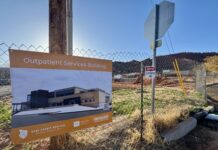Devil’s Advocate: Are new parks bad for St. George?

by Paul Dail
Devil’s advocate: A person who, given a certain issue, takes a position he/she does not necessarily agree with—or simply an alternative position from the accepted norm—for the sake of debate or to explore the thought further.
In December, The St. George Spectrum reported that the long-overdue second phase of the Royal Oaks Park located at 1250 N. 1400 W. in St. George had finally commenced. Started 17 years ago, development on the park, along with other projects in the city, was delayed due to economic constraints. However, the past four years has seen the Parks Department budget almost double. As a result, old plans for putting parks within a half-mile of every resident are being taken off the shelf, dusted off, and polished up. While this may be viewed by most as a positive thing for St. George, the devil’s advocate in me is tempted to ask if there is a side to this issue not being considered.
The good intentions
In addition to having a neighborhood park within a half-mile of every resident, the city would also like to ultimately see a larger community park within a mile of every resident. Even though The Spectrum called the park plans a “long-term goal” of the city, St. George Leisure Services director, Kent Perkins, called it more of “an ongoing, rolling goal.”
“As the community grows, we try to anticipate that growth and be prepared to build parks in those areas where the growth is,” Perkins said. “If there are any current deficiencies, those park sites rise to the top of our priority list.”
Perkins said the passage of the RAP tax in November will likely have little impact on this plan and that most neighborhood parks will be built using impact fees, one-time fees on new construction that are used toward the expansion of city services in order to support growth. Parks fall under this umbrella.
“It’s hard to say with the RAP tax,” Perkins said. “It won’t start to be collected until April, and we don’t know when those distributions will be … For the most part, the RAP tax would be used for [park] facilities that wouldn’t be built by the park impact fees.”
Some of the recent developments resulting from the increased budget include additions to Pioneer Park and Silkwood Park, as well as construction either planned or already underway for several other projects.
Unintended consequences?
There’s an old saying about good intentions and the paving of a certain road.
Another saying along these lines is that no good deed goes unpunished. Even good ideas can have negative consequences. The question when it comes to the concept of parks within a certain distance of every resident is whether anyone is considering some of those potentially negative consequences.
The Utah Department of Alcoholic Beverage Control (DABC) states the following in regards to proximity restrictions for liquor licenses:
Alcoholic beverage licenses may not be granted within specific proximity measurements to a community location; 600 feet measured by ordinary pedestrian travel, or 200 feet measured in a straight line. A “community location” is a church, school, park, playground or library.
Per the DABC, the businesses affected by these restrictions include “state liquor stores, package agencies, full-service and limited restaurants, private clubs, taverns, on-premise beer and banquet catering licenses which are located within proximity to a community location.”
A variance can be requested by a business seeking said license within those proximity restrictions, but it’s quite the process, including a public hearing and written consent from both the “local governmental authority” and the “governing authority of the community location.” If a potential establishment is within the range of more than one of those “community locations,” written consent must be acquired from all of them.
When asked if the establishment of businesses that may want a liquor license was a consideration when planning a location for a new park, Kent Perkins said he hadn’t thought about it too much because most parks are built in residential areas.
“I haven’t come across a site that we had selected for a park that was in an area where typically establishments would be,” Perkins said.
However, one example of a business that has run into this exact problem is the Chef Alfredo restaurant located next to Harmon’s on 700 South. Chef Alfredo is the meatball on this Italian sandwich, with a park on one side and a neighborhood on the other side of 700 South. Add in the fact that the restaurant is also within the restricted distance from a school and a church, and you’re looking at a lot of written consents. After three months at the new location (the restaurant had a previous location on Main St. for three years), owner Chef Alfredo says he is still trying to get his wine license.
“What is an Italian restaurant without a glass of wine?” Chef Alfredo said. According to the restaurant owner, people aren’t coming to his restaurant just to drink. “They come here to dine, and they want a glass of wine with dinner. Now they don’t come here anymore.”
Normally people don’t like devil’s advocates because they say things contrary to popular opinion. I know my wife hates it when I try to get her to see the other side of an issue, but as the 19th Century British Philosopher John Stuart Mill said, “He who knows only his side of the case knows little of that.”
I’m not saying that parks are bad. Nor am I saying that city planners had an ulterior, sinister motive in mind when they came up with this park plan.
However, what seems obvious is that new growth and development require new services, and it’s hard to deny that having a park potentially every 2,640 feet (that’s a half-mile) is going to severely impede businesses such as those defined by the DABC from coming into that new development, especially when you add the additional restrictions they will encounter with any churches or schools in these developments. The fact that no one seems to recognize this (or chooses to ignore it) is reflective of what many would term “old school St. George mentality.”
In regards to new developments and the parks department, Perkins said, “We are usually there first, and then those entities that want to create business have to abide by [the state liquor laws].”
The contradiction in terms seems to be that many in St. George want growth and new development, but only on their terms. They have a very clear picture of what that growth and development is going to look like, and it’s a picture that isn’t very attractive to those who might want to get a drink with dinner or meet with friends at a neighborhood pub after work.
Nor is it attractive to any of those DABC-listed businesses looking to open their doors in St. George, in a state that already makes it hard enough to get a liquor license.
Putting a park on every proverbial street corner is a lofty goal, but does every resident really need a park within a half-mile of their home? I’m probably oversimplifying city planning (and I’m sure I’ll be told as much), but it seems like just putting pins on a map and measuring out a half-mile is a less effective way of planning than considering where the majority of families are living. Or which areas are predominantly older. Consider who is moving into these new developments and from where they are moving, especially given St George’s high retiree population.
While many communities do indeed revolve primarily around family, other communities have additional definitions of “social gatherings.” If the majority of those residents would prefer choices in fine dining as opposed to a park within a stones throw of any doorstep, shouldn’t that be the goal?
In the parlance of my teenage daughter, “I’m just sayin’.”
 Paul D. Dail received his BFA in English with a Creative Writing emphasis from the University of Montana, Missoula. In addition to freelance journalism and web content creation, he also enjoys writing creative nonfiction and fiction (with a penchant for the darker side of the page). His collection of flash fiction, “Free Five,” has spent over a year and a half in the top 50 Kindle Horror Shorts Stories since its publication in 2012. Currently he lives on the outskirts of Kanarraville, surrounded by sagebrush and pinyon junipers with his wife and two children.
Paul D. Dail received his BFA in English with a Creative Writing emphasis from the University of Montana, Missoula. In addition to freelance journalism and web content creation, he also enjoys writing creative nonfiction and fiction (with a penchant for the darker side of the page). His collection of flash fiction, “Free Five,” has spent over a year and a half in the top 50 Kindle Horror Shorts Stories since its publication in 2012. Currently he lives on the outskirts of Kanarraville, surrounded by sagebrush and pinyon junipers with his wife and two children.



